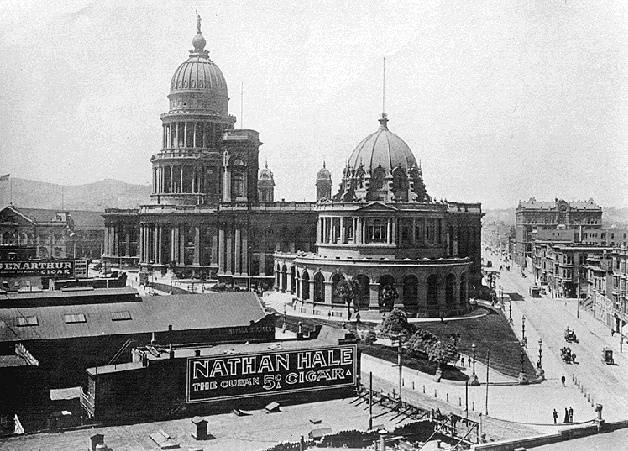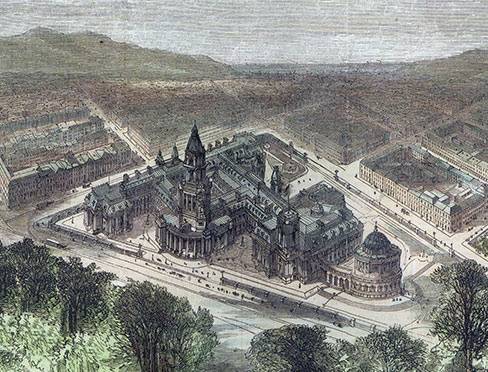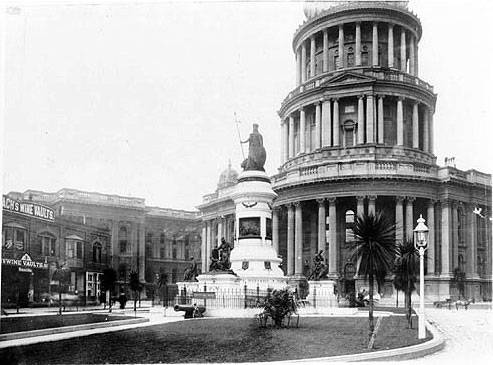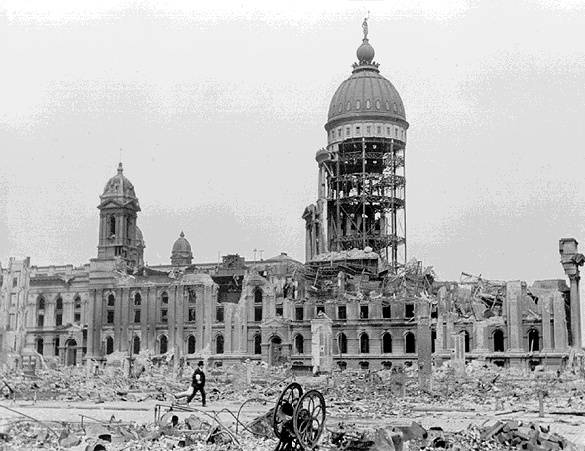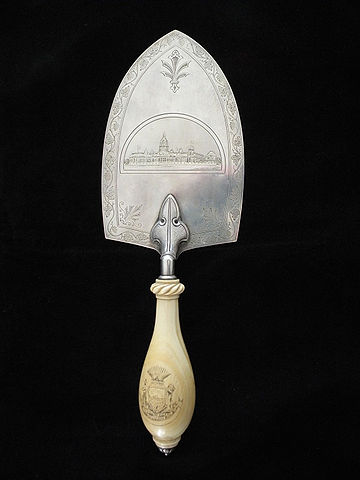Old City Hall of SF: Difference between revisions
mNo edit summary |
(changed photo credits to Private Collection) |
||
| (10 intermediate revisions by one other user not shown) | |||
| Line 5: | Line 5: | ||
[[Image:tendrnob$old-city-hall-1905.jpg]] | [[Image:tendrnob$old-city-hall-1905.jpg]] | ||
'''Old City Hall, built over 25 years, occupied the area where the [[WEEDS |New Main Library]] is today. It was destroyed in the 1906 earthquake and fire.'''< | '''Old City Hall, built over 25 years, occupied the area where the [[WEEDS |New Main Library]] is today. It was destroyed in the 1906 earthquake and fire (see video below).''' | ||
''Photo: Private Collection, San Francisco, CA'' | |||
[[Image:Old city hall drawing ef1a2d766685f99e043c93a91200496f.jpg]] | |||
'''Original vision for the 19th century City Hall.''' | |||
''Image: courtesy Glenn Lym'' | |||
<iframe src="http://archive.org/embed/OldCityHallCorruptionRacismIn19thCenturySanFrancisco" width="500" height="30" frameborder="0"></iframe> | |||
'''Shaping San Francisco Talk on Old City Hall by Glenn Lym, Wed., Dec. 12, 2012''' | |||
[[Image:Hall of Records and City Hall, looking west from City Hall Avenue at McAllister Street, 1877-1897 AAA-4765.jpg]] | |||
'''Hall of Records in foreground, incomplete City Hall behind, westerly view, c. 1880s.''' | |||
''Photo: San Francisco History Center, San Francisco Public Library'' | |||
[[Image:Pioneer-monument-betw-1897-and--06-AAA-4780-cropped.jpg]] | |||
'''Pioneer Monument, which now sits between the Main Library and the Asian Art Museum, once stood here in front of City Hall sometime between 1897 and 1906. After the 1906 earthquake, [[Marshall Square|this spot]] became the intersection of Hyde, Grove, and Market, and in the early 1990s, the statue was moved.''' | |||
''Photo: San Francisco History Center, SF Public Library'' | |||
[[Image:View-from-grant-bldg-1906 old-city-hall.jpg]] | [[Image:View-from-grant-bldg-1906 old-city-hall.jpg]] | ||
| Line 15: | Line 39: | ||
'''Old City Hall, destroyed in 1906 earthquake. After its collapse, it was discovered that it had been built very shoddily; many walls were full of sand.''' | '''Old City Hall, destroyed in 1906 earthquake. After its collapse, it was discovered that it had been built very shoddily; many walls were full of sand.''' | ||
''Photo: | ''Photo: Private Collection, San Francisco, CA'' | ||
<iframe src="http://archive.org/embed/SanFranc1906_6" width="640" height="480" frameborder="0" webkitallowfullscreen="true" mozallowfullscreen="true" allowfullscreen></iframe> | |||
'''Most of these 30 seconds are shot from 8th Street looking north towards where the Pioneer Monument sat in [[Marshall Square|Marshall Square]]. In the early 1990s, the monument sat in the intersection of 8th/Market/Hyde from where it was moved to its current location in the street between the Main Library and the Asian Art Museum. | |||
''Video: [http://archive.org/details/prelinger Prelinger Archive]'' | |||
"The first 'city hall,' before 1840 was an office in a house, or the back room of a hotel which was moved around a lot because of fires and political corruption. By 1869, after a severe earthquake and with a constant influx of people, anyone with a stake in the future of San Francisco wanted to build a spectacular metropolis. So of course they needed a grand city hall. The new city hall was designed as a complex of buildings to be built on a triangular park, the former site of an old cemetery. The state appropriated the land and auctioned off portions of the property--the scheme was to raise a million and a half dollars for construction costs, and get it built in three years. Construction began in 1870, was finished 27 years later, in 1897, and cost six million dollars. Just nine years later it was all but destroyed by the earthquake and fire of 1906. It was a nineteenth-century thing; you give a contract to friends, or friends of friends. With seven chief architects, over twenty-seven years there was ineptitude after ineptitude. The materials were compromised; even the cast bricks were rumored to be shoddy. Fireplaces were built and later heating systems were installed. There were major sewage problems, the place was said to stink all the time. The floors didn't match up, chimneys didn't draw so the rooms were smokey, it was a mess. . . . | "The first 'city hall,' before 1840 was an office in a house, or the back room of a hotel which was moved around a lot because of fires and political corruption. By 1869, after a severe earthquake and with a constant influx of people, anyone with a stake in the future of San Francisco wanted to build a spectacular metropolis. So of course they needed a grand city hall. The new city hall was designed as a complex of buildings to be built on a triangular park, the former site of an old cemetery. The state appropriated the land and auctioned off portions of the property--the scheme was to raise a million and a half dollars for construction costs, and get it built in three years. Construction began in 1870, was finished 27 years later, in 1897, and cost six million dollars. Just nine years later it was all but destroyed by the earthquake and fire of 1906. It was a nineteenth-century thing; you give a contract to friends, or friends of friends. With seven chief architects, over twenty-seven years there was ineptitude after ineptitude. The materials were compromised; even the cast bricks were rumored to be shoddy. Fireplaces were built and later heating systems were installed. There were major sewage problems, the place was said to stink all the time. The floors didn't match up, chimneys didn't draw so the rooms were smokey, it was a mess. . . . | ||
| Line 26: | Line 57: | ||
''from "Going Public: The San Francisco Civic Center" in Reclaiming San Francisco: History, Politics, Culture (City Lights: 1998)'' | ''from "Going Public: The San Francisco Civic Center" in Reclaiming San Francisco: History, Politics, Culture (City Lights: 1998)'' | ||
[[Image:SF-trowel-obverse.jpg|360px|left|thumb]] | |||
'''Obverse of the ceremonial Masonic trowel that dedicated the cornerstone of the City Hall, 22nd February 1872 by Grand Master Leonidas E. Pratt. Property of the [http://www.masonicheritage.org Henry W. Coil Library & Museum of Freemasonry]''' | |||
Latest revision as of 14:24, 9 June 2014
Historical Essay
by Susan Schwartzenberg
Old City Hall, built over 25 years, occupied the area where the New Main Library is today. It was destroyed in the 1906 earthquake and fire (see video below).
Photo: Private Collection, San Francisco, CA
Original vision for the 19th century City Hall.
Image: courtesy Glenn Lym
<iframe src="http://archive.org/embed/OldCityHallCorruptionRacismIn19thCenturySanFrancisco" width="500" height="30" frameborder="0"></iframe>
Shaping San Francisco Talk on Old City Hall by Glenn Lym, Wed., Dec. 12, 2012
Hall of Records in foreground, incomplete City Hall behind, westerly view, c. 1880s.
Photo: San Francisco History Center, San Francisco Public Library
Pioneer Monument, which now sits between the Main Library and the Asian Art Museum, once stood here in front of City Hall sometime between 1897 and 1906. After the 1906 earthquake, this spot became the intersection of Hyde, Grove, and Market, and in the early 1990s, the statue was moved.
Photo: San Francisco History Center, SF Public Library
Sweeping view in May 1906 from Grant Building roof.
Old City Hall, destroyed in 1906 earthquake. After its collapse, it was discovered that it had been built very shoddily; many walls were full of sand.
Photo: Private Collection, San Francisco, CA
<iframe src="http://archive.org/embed/SanFranc1906_6" width="640" height="480" frameborder="0" webkitallowfullscreen="true" mozallowfullscreen="true" allowfullscreen></iframe>
Most of these 30 seconds are shot from 8th Street looking north towards where the Pioneer Monument sat in Marshall Square. In the early 1990s, the monument sat in the intersection of 8th/Market/Hyde from where it was moved to its current location in the street between the Main Library and the Asian Art Museum.
Video: Prelinger Archive
"The first 'city hall,' before 1840 was an office in a house, or the back room of a hotel which was moved around a lot because of fires and political corruption. By 1869, after a severe earthquake and with a constant influx of people, anyone with a stake in the future of San Francisco wanted to build a spectacular metropolis. So of course they needed a grand city hall. The new city hall was designed as a complex of buildings to be built on a triangular park, the former site of an old cemetery. The state appropriated the land and auctioned off portions of the property--the scheme was to raise a million and a half dollars for construction costs, and get it built in three years. Construction began in 1870, was finished 27 years later, in 1897, and cost six million dollars. Just nine years later it was all but destroyed by the earthquake and fire of 1906. It was a nineteenth-century thing; you give a contract to friends, or friends of friends. With seven chief architects, over twenty-seven years there was ineptitude after ineptitude. The materials were compromised; even the cast bricks were rumored to be shoddy. Fireplaces were built and later heating systems were installed. There were major sewage problems, the place was said to stink all the time. The floors didn't match up, chimneys didn't draw so the rooms were smokey, it was a mess. . . .
The design was a Second Empire, French-style emerging in the 1860s in Paris when the monarchy was restored and Napoleon III was in power. Ironically, in 1871 during the Paris Commune, which was in part a rebellion against the monarchy, much of Paris burned. So oddly, this was the architectural style, the democratic ideal adopted for government buildings throughout America. . . . The property which had been sold to raise money remained empty for years and became sort of impromptu demonstration areas--I don't think they had a strong sense of 'public space' at that time. So these lots became the forerunner of the plaza, I guess you could say. They were called the sand lots where workers would congregate and often marches started from there, until of course they plopped the Pioneer monument in the middle. . . ."
--San Francisco City Planner
I study evolutionary theory, as well as human evolution, and the morphological characteristics of human bone--what it goes through--through time and a lifetime. It was the southeast corner of the Civic Center, the site of the old City Hall where the new library was built. But in the 1840s the entire area was the Yerba Buena cemetery--the city's first graveyard. Supposedly, they had moved the bodies in the 1850s, but it was suspected that some remains might still be found--so when they began the excavation for the library I was called to be on site in case there was an exhumation. We found no whole skeletons but some rib and fibula fragments. We found a lot of hand and finger bones, and teeth--things that slip through the cracks. Every day we would comb through the sand, the wind would blow all night and you'd return and see new exposed bones. We found most of it just north of an in-credible brick sewer--a piece of the old infrastructure still underneath the city. Around it we found a lot of Chinese coins, pipes, and jewelry bits, so I assume it was built by Chinese labor. The artifacts were found in the foundation, you don't know what happened. A lot of the things were personal items. Maybe they belonged to the people who worked at City Hall. . . .
from "Going Public: The San Francisco Civic Center" in Reclaiming San Francisco: History, Politics, Culture (City Lights: 1998)
Obverse of the ceremonial Masonic trowel that dedicated the cornerstone of the City Hall, 22nd February 1872 by Grand Master Leonidas E. Pratt. Property of the Henry W. Coil Library & Museum of Freemasonry

